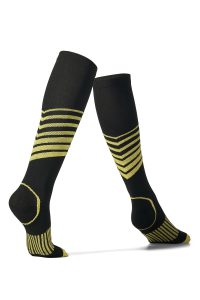 Staying seated during long-haul flights lasting four or more hours can slow down the flow of blood in the legs.
Staying seated during long-haul flights lasting four or more hours can slow down the flow of blood in the legs.
A slow-down in circulation can increase the risk of pulmonary embolism or deep vein thrombosis. Deep vein thrombosis (DVT) occurs when blood clots form in the deep veins in the legs. Pulmonary embolism (PE) occurs when there is a blockage in the pulmonary arteries in the lungs. This is most likely caused by a blood clot that traveled from the deep veins in the legs to the lungs.
DVT and PE can lead to serious and potentially fatal complications. However, there are several things you can do to reduce the risk of developing these problems while flying, one of which is wearing compression socks.
Compression socks work by squeezing or placing pressure on the veins in the legs and feet. This helps with improving circulation and preventing blood from pooling in the veins.
Additional health benefits gained by wearing compression socks are:
- They can help ease swelling in the feet
- They can provide some relief to tired and achy feet
- They can help improve lymphatic drainage
When purchasing a pair of compression socks, there are a few things you should keep in mind:
- They have different levels of pressure, measured in mmHg
- You likely have the wrong size if they feel too tight or painful
If you are flying for an extended period, consider wearing compression socks. But first, speak with your healthcare provider to decide if they are right for you. Compression socks may do more harm than good if not worn properly or if they do not fit correctly.
All content of this newsletter is intended for general information purposes only and is not intended or implied to be a substitute for professional medical advice, diagnosis or treatment. Please consult a medical professional before adopting any of the suggestions on this page. You must never disregard professional medical advice or delay seeking medical treatment based upon any content of this newsletter. PROMPTLY CONSULT YOUR PHYSICIAN OR CALL 911 IF YOU BELIEVE YOU HAVE A MEDICAL EMERGENCY.
